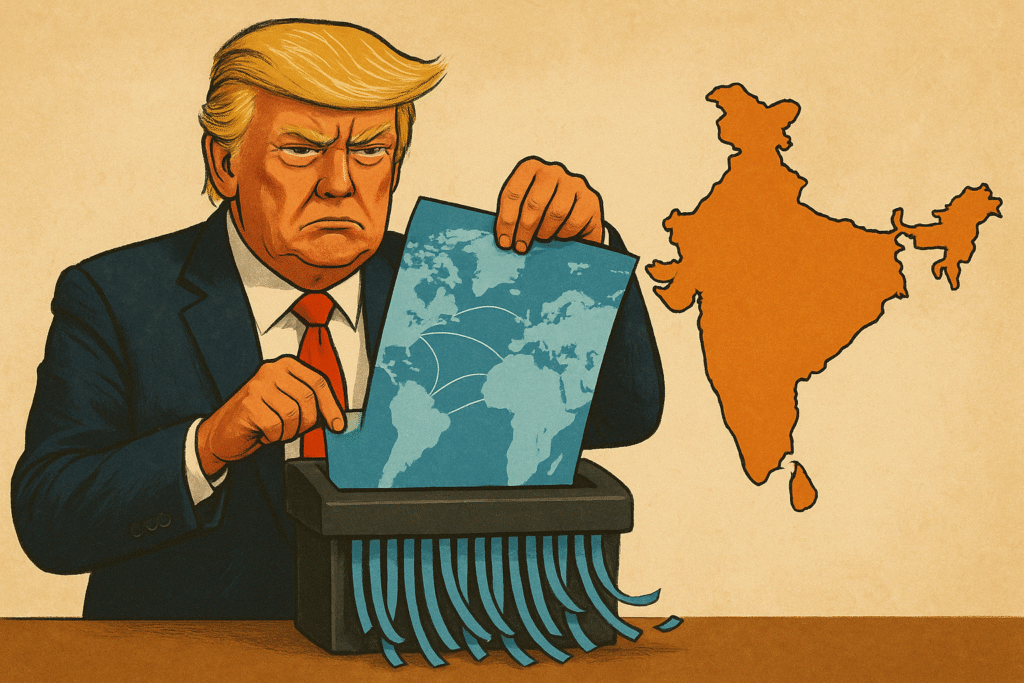Summary
- Trump’s 2025 tariff war dismantles decades of global trade consensus, marking the official end of the liberal economic order.
- India, once a champion of globalisation, now must rewrite its trade playbook while avoiding the pitfalls of over-alignment.
- Cautious diplomacy and deep domestic reform are essential for India’s next big leap on the world stage.
Globalisation’s Collapse and India’s Crossroads
The world has officially entered a post-globalisation era, and this time, it’s not a matter of speculation but political reality. The spark came in the form of US President Donald Trump’s sweeping 27% tariffs—this time, including on Indian goods. But the deeper signal is unmistakable: the foundational assumptions of open markets and integrated supply chains, shaped over the past three decades, have been decisively abandoned by the world’s largest economy.
India, having been one of globalisation’s late but enthusiastic adopters since the 1991 reforms, is now being forced to reconsider not just its trade strategy but its entire economic outlook. Prime Minister Narendra Modi’s February visit to Washington, followed by the Centre’s measured response to Trump’s protectionist move, highlights New Delhi’s grasp of the tectonic shift underway.
Yet, this is not a moment for mere damage control. It is an inflection point—one that demands foresight, restraint, and radical reform.
Straight Talk | Tariffs And Tectonic Shifts: Trump’s Trade War Can Catapult India Forward
— Sanbeer Singh Ranhotra (@SSanbeer) April 17, 2025
As Trump targets China, India becomes the world’s safe bet.
Over the past decade, the term “supply chain diversification" has gone from being a technical trade term to a real-time… pic.twitter.com/YjfiNmdOG1
Delhi’s Diplomatic Pivot in a Fractured World
- India refrained from retaliatory tariffs, choosing backchannel diplomacy over rhetorical escalation.
- Bilateral trade talks with the US have accelerated, focused on exemptions and supply chain partnerships.
- Modi’s Washington visit signalled India’s intent to maintain strategic autonomy, even under intense pressure.
As Washington reorients from global policeman to nationalist enforcer, India is recalibrating its place in a more fragmented world. Instead of succumbing to nationalist provocation or aligning blindly with the West, Delhi is betting on multi-alignment—a strategy of retaining strategic autonomy while deepening ties where interests converge.
Trade talks in recent weeks reflect a search for exceptions, not confrontations. While the 27% tariff is economically disruptive, Delhi’s silence shows a mature recognition of how deeply domestic politics now defines global trade. India understands that Trump’s move isn’t a negotiation tactic—it’s a worldview.
Therein lies the new game: globalisation is no longer shaped by economic efficiency but by political optics, especially in the US and EU. Delhi’s challenge is to stay engaged while quietly rewiring its own model.
The Urgency of Internal Reform—Not Rhetoric
- India’s export share of GDP has stagnated at ~20%, while peers like Vietnam and Bangladesh surge ahead.
- Regulatory overhang, logistical bottlenecks, and skill gaps continue to deter manufacturing inflows.
- Without bold reforms in land, labour, and credit markets, India risks missing the next supply chain wave.
If global markets are closing and old rules are dead, India’s response cannot simply be reactive diplomacy or subsidy-driven decoupling. The real battle is domestic. And here, India’s record is mixed.
While PLI schemes, digital infrastructure, and a steady tax regime have helped, they are not enough. India must now address second-generation reforms—those it has long postponed due to political risk. These include:
Without these, India will remain stuck as a consumer market, not a production powerhouse. The collapse of globalisation offers a rare opening to win back supply chains fleeing China—but India must earn its seat.

The Real Realignment: A World Without Guarantees
- Trump’s “America First” policies are now bipartisan in tone, not a political aberration.
- China’s economic coercion has made middle powers wary of overdependence on any one bloc.
- India must build coalitions of economic resilience—with Southeast Asia, Africa, and the Global South.
The post-globalisation world will not be divided between East and West—but between insulated and integrated players. And the new map won’t follow geography but trust.
Here, India’s historical strengths—non-alignment, institutional credibility, demographic scale—offer a unique advantage. But only if New Delhi can combine it with speed, delivery, and a clear economic vision. The next five years will determine whether India becomes the bridge in a divided world—or just another casualty of collapsing consensus.
A New Delhi Consensus?
India now stands at the edge of a global reset. Trump’s tariffs are not just an economic blow but a reminder that even the most stable frameworks can be torn apart by politics. There will be no return to the 1990s. And perhaps, there shouldn’t be.
India must now write its own playbook—not just as a response to Trump, but to the wider unraveling of the global order. That means putting domestic reform above populist promises, focusing on execution rather than entitlement, and building a trade policy that reflects India’s emerging scale and sovereignty.
The old globalisation map is gone. What emerges next is unclear. But India, if it dares to reform boldly and navigate prudently, could be one of the few nations shaping the contours of what comes next.


